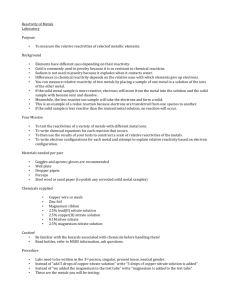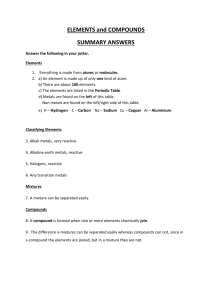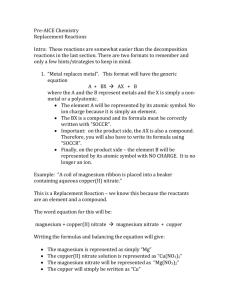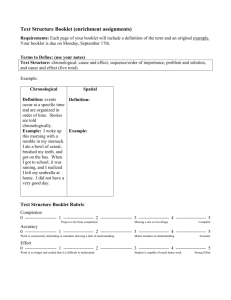Problem Solving – Part 2
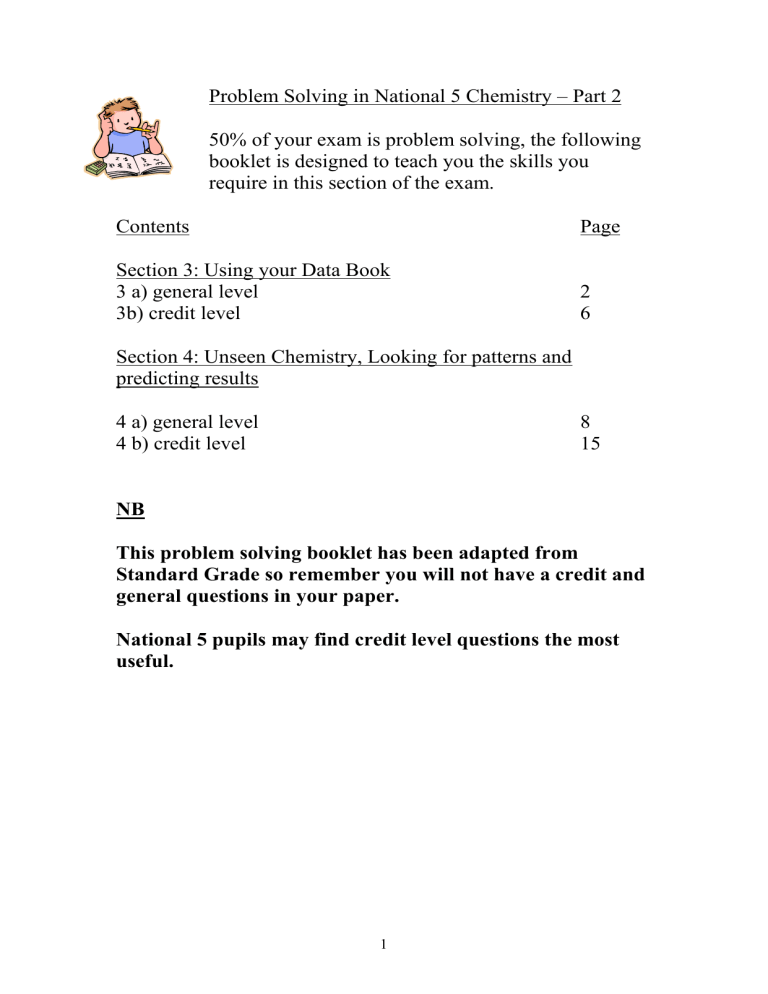
Problem Solving in National 5 Chemistry – Part 2
50% of your exam is problem solving, the following booklet is designed to teach you the skills you require in this section of the exam.
Contents
Section 3: Using your Data Book
3 a) general level
3b) credit level
Page
2
6
Section 4: Unseen Chemistry, Looking for patterns and predicting results
4 a) general level
4 b) credit level
8
15
NB
This problem solving booklet has been adapted from
Standard Grade so remember you will not have a credit and general questions in your paper.
National 5 pupils may find credit level questions the most useful.
1
Section 3: Using your Data Book
3 a) General Level
Your data book contains lots of useful information. In fact there are questions that you cannot answer without it. You need to get familiar with using the contents page and become confident using it to answer questions. The following are all from general past paper questions.
1) The grid contains the names of some elements.
A) NEON B) LITHIUM C) CHLORINE
D) OXYGEN E) COPPER F) ARGON a) identify the element with the highest melting point?
(you may wish to use page 3 of the data book to help you.) b) identify the two very unreactive elements?
2) Hydrocarbons are elements containing Hydrogen and carbon only.
A) CH
4
B) C
2
H
4
C)C
6
H
14
D) C
5
H
12
E) C
3
H
8
F) C
4
H
8 a) Identify the hydrocarbon which has a boiling point of 69 o C
You may wish to use page 6 of the data booklet to help you. b) Identify the TWO molecular formulae which represent alkenes. c) Identify the hydrocarbon with the highest boiling point.
3) The grid contains the names of some metals.
A) ZINC B) CALCIUM C) IRON
D) MAGNESIUM E) SILVER F) SODIUM a) identify the metal which does not react with dilute acid.
4) The periodic table on page 8 of the data booklet shows the names of the elements.
A) chlorine B) copper C) oxygen
D) lithium E) sulphur F) bromine a) Identify the TWO elements in the same group as fluorine. b) Identify the element which is a transition metal. c) Identify the TWO elements which were discovered in 1774.
5) Pairs of metals can be used to produce a voltage. A cell was set up with zinc and copper and salt solution.
2
A) magnesium
C) tin
B) lead
D) iron
Identify the metal which would give the smallest voltage if used in place of zinc. You may wish to use page 7 of the data booklet to help you.
6) The symbols of some elements are shown below. You may wish to use page 8 of the data booklet. The periodic table on page 8 of the data booklet shows the names of the elements.
A) Kr B) Po C) K
D) P E) Pt F) Pb a) Identify the symbol for Potassium. b) Identify the two elements discovered in the same year. c) Identify the element used as a catalyst in a catalytic convertor.
7) Hydrocarbons are elements containing Hydrogen and carbon only. Some formulae are shown below.
A) CH
4
B) C
2
H
4
C)C
6
H
14
D) C
5
H
12
E) C
4
H
10
F) C
4
H
8
Identify the 2 hydrocarbons which could be produced when propane(C
3
H
8
) is cracked. b) Identify the TWO unsaturated hydrocarbons c) Identify the hydrocarbon with the highest boiling point. You may wish to use page 6 of the data booklet to help you.
8) Plants need phosphorous to grow. Suggest why Calcium phosphate is not suitable as a fertiliser.
9) The table contains information about some popular gemstones.
Name Formula of main Common Source of colour chemical
Diamond C colour
Colourless ---------
Amethyst SiO
2
Sapphire Al
2
O
3
Purple
Blue
Iron compounds
Titanium and iron
Emerald Be
3
Al
2 sI
6
O
13
Ruby Al
2
O
3
Green
Red compounds
Chromium compounds
Chromium compounds a) name the main chemical found in both sapphire and ruby. b) What type of metal element is present in the compounds which cause the colour in the gemstones? You may wish to use page 8 of the data booklet to help you. c) Diamond does not conduct electricity. Name the form of carbon which conducts electricity.
3
10) The diagram shows part of the periodic table. The letters not represent the symbols for the elements. a) Identify the element which has the same electron arrangement 2,5. b) Identify the TWO elements with similar chemical properties c) Identify the noble gas.
11) The names and boiling points of some of the fractions obtained from crude oil are shown below.
Fraction Boiling Point O C
Gases Below 20
Naptha
Kerosine
Gas oils
20-175
150-240
220-350
Residue Above 350
In which fraction is propane found? You may wish to use page 6 of the data booklet.
12) The reactivity of metals can be compared by adding them to a mixture of hydrochloric acid and detergent. Amy set up 5 test tubes each containing a different metal.
4
a) Name one factor which Amy would have kept the same to ensure a fair comparison. b) Suggest a name for metal X. You may wish to use page 7 of the data booklet.
Section 3: Using your Data Book
5
3 b) Credit Level
Your data book contains lots of useful information. In fact there are questions that you cannot answer without it. You need to get familiar with using the contents page and become confident using it to answer questions. The following are all from credit past paper questions.
1) Identify the TWO particles with the same electron arrangement as neon.
A)
24
Na
11
D)
24
Mg
2+
12
B)
E)
14
6
19
F
-
9
C C)
19
F)
12
9
6
F
C
2) The grid shows the names of some chemical compounds
A) sodium hydroxide B) potassium nitrate C) sodium chloride
D) lithium carbonate E) sodium phosphate F) barium sulphate
Identify the compound which could be prepared by precipitation. You may wish to use page 5 of the data book.
3) The names of some hydrocarbons are shown in the grid.
A) cyclobutane B)cyclopentane C)butane
D) propane E) ethane F) butene a) Identify the hydrocarbon which is a liquid at 25 o C. You may wish to use the data booklet to help you. b) Identify the two isomers. c) Identify the hydrocarbon that reacts quickly with bromine solution.
4) The grid shown the names of some soluble compounds.
A) magnesium bromide B) sodium bromide C) lithium hydroxide
D) sodium iodide E)potassium sulphate F) lithium chloride a) Identify the base b) Identify the TWO compounds whose solutions would form a precipitate when mixed. You may wish to use the data booklet to help you. c) Identify the compound with a formula of the type XY
2
, where X is a metal.
5) Identify the TWO particles with the same electron arrangement as argon.
A)
40
Ca
20
D)
34
S
2-
16
B)
E)
24
Mg
12
35
Cl
-
17
2+
C)
39
F)
40
K
19
K
19
6) Chlorine is produced by the electrolysis of sodium chloride solution. Write the ionelectron equation for the formation of chlorine. You may wish to use your data booklet to help you.
7) The grid shows the names of some elements.
A) argon B) potassium C) magnesium
6
D) chlorine E) phosphorus F) sulphur a) Identify the element which produces a lilac flame colour. You may wish to use your data booklet to help you. b) Identify the element with atoms which have the same electron arrangement as a
Ca
2+
ion. c) Identify the TWO elements which would form a covalent compound with a formula of type X
3
Y
2
8) When two different metals are joined in a cell, a chemical reaction takes place and a voltage is produced. During the reaction one of the metals corrodes. a)Which pair of metals would produce a flow of electrons in the direction of metal B to metal A and would produce a blue colour around metal B? b) Which pair of metals would produce the biggest voltage? You may wish to use page 7 of the data booklet to help you.
9) The grid shows the symbols for some elements.
A) Al B) Na
D) Mg E) O
C) P
F) Ba
You may want to use page 1 of the data booklet to help you. a) Identify the TWO elements which have atoms with the same number of outer electrons. b) Identify the TWO elements which react to form a covalent compound. c) Identify the TWO elements which form an ionic compound with a formula of the type X
2
Y where X is a metal.
10) The names and boiling points of some of the fractions obtained from crude oil at the BP refinery in Grangemouth are shown below.
Fraction Boiling Point O C
Gases
Naptha
Below 20
20-120
Kerosine
Gas oils
120-240
220-350
Residue Above 350 a) In which fraction is pentane found? You may wish to use page 6 of the data booklet.
Section 4: Unseen Chemistry, Looking for patterns and predicting resuts
7
4 a) general level
Most of the other problem solving questions, involve unseen chemistry , where enough information will be given for you to follow a pattern or predict a result .
They may also ask you to apply previous knowledge in new situations . It is important not to think “I’ve never seen this before so I can’t do it” Practicing these questions will give you confidence in your exam when you meet new situations.
Try the following general examples.
Q1) Lorraine added magnesium carbonate powder to dilute Hydrochloric acid in a beaker until no more reacted. The contents of the beaker were then filtered into a conical flask.
MgCO
3
(s) + 2HCl(aq) -> MgCl
2
(aq) +CO
2
(g) + H
2
O(l)
A Magnesium carbonate MgCO
3
B Hydrochloric acid HCl
C magnesium chloride MgCl
2
D Carbon dioxide CO
2
E Water H
2
O a) Identify the residue X b) Identify the two substances collected in the flask
Q2) Heptane is cracked using aluminium oxide as the catalyst. One of the reactions that takes place is:
C
7
H
16
(l) -> C
3
H
6
(g) + X a) Name the product C
3
H
6 b) Write the molecular formula for X c) Aluminium oxide is a white solid but at the end of the experiment it is covered in a black substance. Suggest what the black substance could be.
Q3) When Mathew added manganese dioxide to hydrogen peroxide solution, oxygen was produced. Manganese dioxide was the catalyst a) What will be the mass of the manganese dioxide at the end of the experiement.
8
b) He then wanted to see if raising the temperature to 35 o
C would speed up the reaction. c) Complete the labelling of the diagram to show how he would make his second experiment a fair test.
Q4) A chemist used the following apparatus to investigate biogas. Biogas is a mixture of carbon dioxide and methane.
80 cm
3
of biogas was bubbled into the sodium hydroxide solution which removed the carbon dioxide. The remaining gas was collected in syringe B. a) copy and complete the diagram to show how the biogas was passed into the sodium hydroxide solution. b) She found that the biogas contained 60% carbon dioxide and 40% methane. What volume of gas was collected in syringe B?
Q5) Fiona was investigating the reaction of two different metals with dilute sulphuric acid. She changed the concentration of the acid and timed how long it took for each metal to produce 10cm
3 of Hydrogen gas.
Concentration of acid/
Moles per litre
Time taken to produce
Metal A
10cm 3 of gas in seconds
Metal B
1
2
62 s
27s
87s
41s a) State whether A or B is the more reactive metal. b) Identify a variable that Fiona would have kept constant during her experiment.
9
Q6)
Identify the two experiments which could be compared to show the effect of pH on the dyeing of cloth.
Q7) Hard water is water which needs a lot of soap to produce a lather. The harder the water, the more soap that is required to produce a lather. Mark and Gillian investigated the effect of boiling on the hardness of four water samples.
Water Sample Number of drops of soap
(before boiling)
Needed to produce a lather
(after boiling)
A
B
C
25
30
7
12
10
4
D 21 10 a) Which water sample was the hardest before boiling? b) What effect does boiling have on the hardness of water?
Q8) The chart shows the pH ranges of water in which different organisms can survive.
10
a) The water in a healthy loch has a pH of 6.5 Name the organism which would
NOT be found in this loch. b) Give a reason why the pH of the water has decreased in many lochs. c) A loch had no trout but contained perch. Suggest a pH value for the water in his loch.
Q9) The table contains information about the reaction of magnesium with some elements in group 7.
Product Element Observation when element reacts with hot magnesium
Chlorine Magnesium glows brightly
Bromine Magnesium glows red hot
Magnesium chloride
Magnesium bromide
Iodine Magnesium gives a dull glow Magnesium iodide
Predict what would be seen when hot magnesium reacts with fluorine.
Q10) The analysis of salts is important in forensic science. Salts connected with certain occupations are shown below.
Occupation
Plasterer
Farmer
Salts(s)
Calcium sulphate
Ammonium nitrate
Ammonium sulphate
A forensic scientist carried out a flame test on some powder scraped from a plasterer’s work clothes. What colour of flame would have been seen?
(You may wish to use page 4 of your data booklet)
Q11) The grid shows the names of some metals.
11
A) copper
D) brass
B) magnesium
E) sodium
C) zinc
F) steel a) Identify the metal which produces a yellow light in a street lamp.( You may wish to use page 4 of your data booklet) b) Identify 2 alloys.
Q12) Mr Clarke carried out an experiment with different elements. His instruction card is shown below:
Step 1- burn element in oxygen
Step 2- Add water to the oxide formed
Step 3- Add universal indicator
Step 4- Compare the colour of the indicator with a pH chart. a) (i) Copy and complete the table showing the results Mr Clarke would have obtained.
Name of Oxide pH of solution
Carbon dioxide
Sodium oxide
Aluminium oxide Could not be measured
(ii) Suggest a reason why the pH of Aluminium oxide could not be measured. You may wish to use page 5 of the data book.
Q13) Using the following apparatus, describe how you would compare the viscosity of petrol with the viscosity of lubricating oil.
burette
beaker
petrol
lubricating oil
timer
Q14) Information on group 7 elements are shown in the table
Name Atomic number Boiling Point / o C
FLOURINE 9 -188
CHLORINE
BROMINE
17
35
-35
59
IODINE
ASTATINE
53
85 a) What happens to the boiling point as the atomic number increases? b) Predict the boiling point of astatine.
184
Q15) Manganese dioxide (s) acts as a catalyst in the following reaction:
12
Hydrogen peroxide(aq)
water (l)+ oxygen(g)
Several experiments were carried out using the same mass of manganese dioxide and the same volume of hydrogen peroxide solution.
Concentration of hydrogen peroxide solution(mol/l)
A 0.5
B 1.0 o
Temperature/
C
20
30
Form of manganese dioxide
Powder lump
C 1.5
D 1.5
E 0.5
F 2.0
20
30
20
20 lump
Powder lump
Powder
Identify the two experiments which should be compared to show the effect of particle size on the speed of reaction.
Q16) Wilma investigated the reaction of the metals R, S and T with water. a) Place the metals in order of reactivity (most reactive first) b) Identify a variable that Wilma would have kept constant. c) Why is it unsafe to use potassium metal in this experiment?
Q17) EXCESS copper carbonate was added to dilute Hydrochloric acid in a beaker.
CuCO
3
(s) +2HCl(aq) -> CuCl
2
(aq) + CO
2
(g) +H
2
O(l)
When the reaction had finished the contents of the beaker were filtered.
A Copper carbonate (CuCO
3
)
B Hydrochloric acid (HCl)
C Copper chloride (CuCl
2
)
D Carbon dioxide (CO
2
)
E Water (H
2
O) a) Identify the residue b) Identify the substance(s) which collected in the flask.
Q18) Decane can break down in the following way:
13
C
10
H
22
-> C
7
H
16
+ X
Write down the molecular formula for X
Q19) Egg shells and sea shells contain calcium carbonate. Calcium carbonate reacts with dilute hydrochloric acid to produce carbon dioxide gas.
Adam wanted to find out which type of shell contained the most calcium carbonate.
He set up the experiment shown below. a) state TWO ways in which Adam would know when the reaction had finished. b) Adam repeated the experiment using 5g sea shell. His results are shown in the table.
Sea shell Egg shell
Balance reading at start/g 106.19 106.19
Balance reading at end/g 104.22 104.01
Which type of shell contained the most calcium carbonate?
Section 4: Unseen Chemistry, Looking for patterns and predicting resuts
14
4 b) credit level
Most of the other problem solving questions, involve unseen chemistry , where enough information will be given for you to follow a pattern or predict a result .
They may also ask you to apply previous knowledge in new situations . It is important not to think “I’ve never seen this before so I can’t do it” Practicing these questions will give you confidence in your exam when you meet new situations.
Try the following credit examples.
Q1) Iron and magnesium both react with dilute hydrochloric acid. a) Identify the experiment with the slowest rate of reaction. b) Identify the TWO experiments which could be used to investigate the effect of temperature on the rate of reaction.
Q2) Mr Sharpe demonstrated the fractional distillation of crude oil to class 3B
15
a) Identify the true statement(s)
A Fraction 6 evaporates more easily
B Fraction 4 is more viscous than fraction 3
C Fraction 2 is more flammable than fraction 1
D Fraction 5 has a lower boiling range than fraction 4
E The molecules in fraction 3 are larger than those in fraction 2
Q3) When chlorine gas is prepared in a fume cupboard it contains acid fumes.
16
The chlorine gas is bubbled through water to remove the acid fumes. It is then bubbled through concentrated sulphuric acid to dry the gas. The dried gas is collected in a gas jar.
Complete and label the diagram to show how a sample of dry gas could be obtained.
Q4) The temperature scale shows the melting points of three compounds a) use the information on page 6 of the data booklet to help you complete a temperature scale showing the boiling points of the above compounds. Copy and complete the diagram on the next page.
17
b) Name the compound which is liquid at -25 o
C.
Q5) The uses of metals are related to their properties.
Metal Density (g/cm
3
) Relative strength Relative electrical conductivity
Aluminium 2.7 1.0 3.8
Steel
Copper
7.9
8.9
4.0
2.5
1.0
5.9
Overhead electricity cables have a steel core surrounded by an aluminium sheath.
Using the information in the table, suggest: a) an advantage of using aluminium rather than copper for the cable. b) Why cables have a steel core.
Q6) Visking tubing can be used to model the gut wall. a) describe how you would show that starch molecules are too large to pass through the visking tubing.
18
During digestion starch is hydrolysed by amylase. b) Using all the chemical and apparatus listed below describe the experiment you would carry out to show that hydrolysed starch can pass through the visking tubing.(You may wish to draw a diagram) You may use other apparatus if required.
Chemicals and apparatus:
Starch in water
Amylase solution
Test tube of water
Prepared visking tubing
Benedicts solution
Q7) Ethanol is the second member of the alkanol family. The combustion of an alkanol releases heat energy.
Name of Alkanol
Methanol
Ethanol
Propanol
Butanol
Heat released when one mole of alkanol is burned(kJ)
726
1367
2017
2665 a) Make a general statement linking the amount of heat released and the number of carbon atoms in the alkanol molecule. b) Predict the amount of heat released, when 1 mole of pentanol burns.
Q8) Frank and Dave carried out several experiments with metals and acids
Identify the two experiments which should be compared to show the effect of particle size on reaction rate.
19
Q9) The table below shows the names and colours of some common ions.
Ion
Copper
Nickel
Formula Colour
Cu
2+
Ni
2+
Blue
Green
Zinc
Lithium
Zn
2+
Li
+
Colourless
Colourless
Magnesium Mg
2+
Colourless
Nitrate NO
3
-
Colourless
Sulphate SO
4
2Colourless
Permanganate MnO
4
-
Purple dichromate Cr
2
O
7
2orange
Identify the true statement(s) based on the information in the table.
A Copper nitrate is blue
B Coloured ions contain transition metals
C Ions containing oxygen are colourless
D All transition metal ions are colourless
E All lithium compounds are colourless
Q10) To turn a gas into a liquid it must be cooled below a temperature known as the critical temperature.
Gas
HYDROGEN
HELIUM
Formula Relative Formula mass
H
2
He
2
4
Critical Temperature/ o C
-240
-268
AMMONIA
OXYGEN
NH
3
O
2
CO
2
17
32
CARBON
DIOXIDE
44
Identify the true statements(s) based on the information in the table.
A Compounds have higher critical temperatures than elements
133
-119
31
B Critical temperature increases as relative formula mass increases
C Diatomic elements have higher critical temperatures than monatomic elements
D Carbon dioxide can be a liquid at 40 o C
A
B
C
Q11) Andrew investigated the effect of different hydrocarbons on bromine solution.
Hydrocarbon Formula Effect on bromine solution
D
C
C
C
C
5
6
5
5
H
H
H
H
12
12
10
10
(i)
No effect
No effect
Quickly decolourised
(i) Complete the table to show the effect of hydrocarbon A on bromine solution.
(ii) Name hydrocarbon B
(iii) What term is used to describe a pair of hydrocarbons like C and D
20
Q12) Siobhan carried out some experiments with four metals( W,X,Y and Z ) and some of their compounds. She made the following observations.
When each metal was placed in cold water, only metal Y reacted. Only metal W was obtained from its oxide by heating. When metal X was placed in a solution containing ions of metal Z, metal X dissolved and solid metal Z was formed. a) Suggest names for metals W and Y. b) Place the four metals( W,X,Y and Z ) in order of reactivity.(most reactive first)
Q13) The table compares the mass of ions found in ocean water with the mass of ions found in water from the dead sea.
Ion Mass in 1 Litre of ocean water/g
Mass in 1 litre of Dead sea water/g
Na
+
K
+
Mg
2+
Ca
2+
Cl
-
Br
-
SO
4
2-
10.7
0.4
1.3
0.4
19.2
0.1
2.5
31.5
6.8
36.2
13.4
183.0
5.2
0.6 a) What general statement can be made about the mass of ions in water from the
Dead Sea compared with ocean water? b) Suggest a name for a compound which might be obtained if a sample of water from the dead sea was evaporated to dryness.
Q14) The alkynes are a family of hydrocarbons which contain a carbon to carbon triple bond. a)suggest a general formula for the alkynes b)Alkynes are prepared by reacting a dibromoalkane with sodium hydroxide
Dibromoalkane
21
(i) Draw the structural formula for the alkyne formed when the dibromoalkane shown below reacts with sodium hydroxide.
(ii) Suggest why the dibromoalkane shown below does NOT form an alkyne when heated with sodium hydroxide.
Q15) In Industry, ethanol (alcohol) can be produced from ethane as shown below. a)Name the type of chemical reaction taking place. b)Draw a structural formula for the product of the following reaction.
22
Q16) Alcohols can be oxidised by hot copper(II)oxide. The product is either an aldehyde or a ketone. a) (i) Aldehydes and Ketones have the same general formula. Suggest a general formula for these compounds.
(iii) write a general statement linking the type of product to the structure of the alcohol used.
Q17) The table contains information about some solid,liquid and gaseous compounds.
Compound Melting Point/ o
C Boiling Point/ o
C pH of solution in water
A
B
319
801
1390
1413
11
7
C
D
E
F
-115
-93
-95
63
-85
-6
56
189
3
11
7
3 a) Identify the compound which is a gas at 25 o C and forms an acidic solution. b) Identify the compound which could be sodium hydroxide.
23
Q18) A pupil carried out the following experiments. a) Identify the two experiments which can be used to investigate the effect of concentration on the rate of the reaction. b) Identify the experiment with the fastest reaction rate.
Q19) Dienes are a homologous series of hydrocarbons which contain two double bonds per molecule. a) Suggest a general formula for the dienes. b) Write the molecular formula for the product of the complete reaction of penta-
1,3-diene with bromine. c) Draw the full structural formula for an isomer of buta-1,3-diene which contains only 1 double bond per molecule.
24
Q20) A pupil carried out a titration using the chemicals and apparatus shown below. a) How would the pupil know when to stop adding acid from the burette? b) What average volume should be used to calculate the number of moles of sulphuric acid needed to neutralise the potassium hydroxide solution?
Q21) David was studying the reactions of some metals and their compounds. He carried out experiments involving Magnesium, copper, zinc, nickel, silver and an unknown metal X. Listed below are some of the observations he recorded.
A X was more readily oxidised than copper
B X oxide was more stable to heat than silver oxide
C Magnesium displaced X from a solution of X nitrate.
D X reacted more vigorously than Nickel in diltute acid
E Compounds of X were more readily reduced than compounds of zinc.
From his observations, David produced the following order of reactivity.(most reactive first0
Magnesium,zinc,nickel,copper, X,silver
Identify the two observations which can be used to show that X has been wrongly placed.
25
Q22) Methane(CH
4
), ethane (C
2
H
6
) and propane (C
3
H
8
) are the first three members of the alkanes. a) The ninth member of the alkanes in nonane (C
9
H
20
). Predict the boiling point of nonane. You may wish to use your databooklet. b) Alkanes can be made by the reaction of sodium with iodoalkanes. For example butane can be made from iodoethane
Butane can also be made using two different iodoalkanes. Name them.
26

